Xiangyu Gao
Pegasus: A Universal Framework for Scalable Deep Learning Inference on the Dataplane
Jun 06, 2025Abstract:The paradigm of Intelligent DataPlane (IDP) embeds deep learning (DL) models on the network dataplane to enable intelligent traffic analysis at line-speed. However, the current use of the match-action table (MAT) abstraction on the dataplane is misaligned with DL inference, leading to several key limitations, including accuracy degradation, limited scale, and lack of generality. This paper proposes Pegasus to address these limitations. Pegasus translates DL operations into three dataplane-oriented primitives to achieve generality: Partition, Map, and SumReduce. Specifically, Partition "divides" high-dimensional features into multiple low-dimensional vectors, making them more suitable for the dataplane; Map "conquers" computations on the low-dimensional vectors in parallel with the technique of fuzzy matching, while SumReduce "combines" the computation results. Additionally, Pegasus employs Primitive Fusion to merge computations, improving scalability. Finally, Pegasus adopts full precision weights with fixed-point activations to improve accuracy. Our implementation on a P4 switch demonstrates that Pegasus can effectively support various types of DL models, including Multi-Layer Perceptron (MLP), Recurrent Neural Network (RNN), Convolutional Neural Network (CNN), and AutoEncoder models on the dataplane. Meanwhile, Pegasus outperforms state-of-the-art approaches with an average accuracy improvement of up to 22.8%, along with up to 248x larger model size and 212x larger input scale.
Modulating CNN Features with Pre-Trained ViT Representations for Open-Vocabulary Object Detection
Jan 28, 2025Abstract:Owing to large-scale image-text contrastive training, pre-trained vision language model (VLM) like CLIP shows superior open-vocabulary recognition ability. Most existing open-vocabulary object detectors attempt to utilize the pre-trained VLM to attain generative representation. F-ViT uses the pre-trained visual encoder as the backbone network and freezes it during training. However, the frozen backbone doesn't benefit from the labeled data to strengthen the representation. Therefore, we propose a novel two-branch backbone network design, named as ViT-Feature-Modulated Multi-Scale Convolutional network (VMCNet). VMCNet consists of a trainable convolutional branch, a frozen pre-trained ViT branch and a feature modulation module. The trainable CNN branch could be optimized with labeled data while the frozen pre-trained ViT branch could keep the representation ability derived from large-scale pre-training. Then, the proposed feature modulation module could modulate the multi-scale CNN features with the representations from ViT branch. With the proposed mixed structure, detector is more likely to discover novel categories. Evaluated on two popular benchmarks, our method boosts the detection performance on novel category and outperforms the baseline. On OV-COCO, the proposed method achieves 44.3 AP$_{50}^{\mathrm{novel}}$ with ViT-B/16 and 48.5 AP$_{50}^{\mathrm{novel}}$ with ViT-L/14. On OV-LVIS, VMCNet with ViT-B/16 and ViT-L/14 reaches 27.8 and 38.4 mAP$_{r}$.
MMW-Carry: Enhancing Carry Object Detection through Millimeter-Wave Radar-Camera Fusion
Feb 24, 2024



Abstract:This paper introduces MMW-Carry, a system designed to predict the probability of individuals carrying various objects using millimeter-wave radar signals, complemented by camera input. The primary goal of MMW-Carry is to provide a rapid and cost-effective preliminary screening solution, specifically tailored for non-super-sensitive scenarios. Overall, MMW-Carry achieves significant advancements in two crucial aspects. Firstly, it addresses localization challenges in complex indoor environments caused by multi-path reflections, enhancing the system's overall robustness. This is accomplished by the integration of camera-based human detection, tracking, and the radar-camera plane transformation for obtaining subjects' spatial occupancy region, followed by a zooming-in operation on the radar images. Secondly, the system performance is elevated by leveraging long-term observation of a subject. This is realized through the intelligent fusion of neural network results from multiple different-view radar images of an in-track moving subject and their carried objects, facilitated by a proposed knowledge-transfer module. Our experiment results demonstrate that MMW-Carry detects objects with an average error rate of 25.22\% false positives and a 21.71\% missing rate for individuals moving randomly in a large indoor space, carrying the common-in-everyday-life objects, both in open carry or concealed ways. These findings affirm MMW-Carry's potential to extend its capabilities to detect a broader range of objects for diverse applications.
Learning for Semantic Knowledge Base-Guided Online Feature Transmission in Dynamic Channels
Nov 30, 2023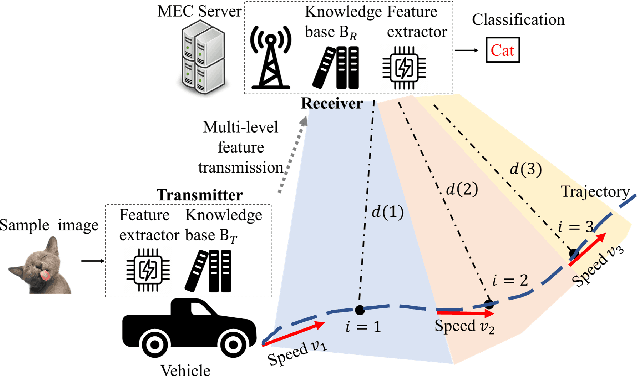
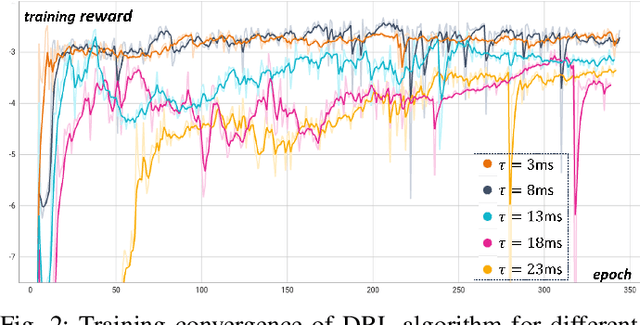
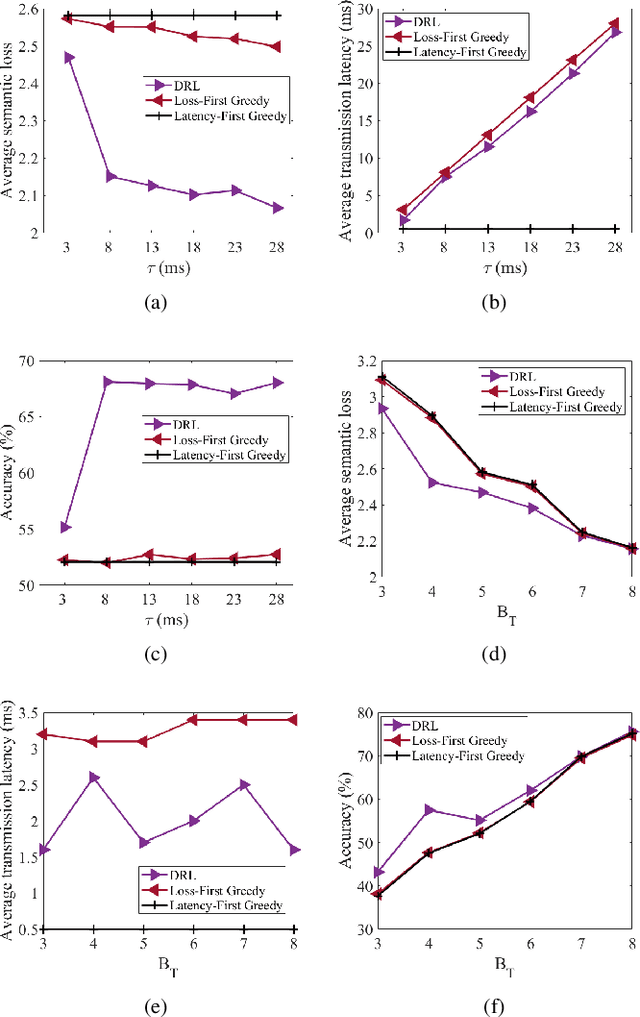
Abstract:With the proliferation of edge computing, efficient AI inference on edge devices has become essential for intelligent applications such as autonomous vehicles and VR/AR. In this context, we address the problem of efficient remote object recognition by optimizing feature transmission between mobile devices and edge servers. We propose an online optimization framework to address the challenge of dynamic channel conditions and device mobility in an end-to-end communication system. Our approach builds upon existing methods by leveraging a semantic knowledge base to drive multi-level feature transmission, accounting for temporal factors and dynamic elements throughout the transmission process. To solve the online optimization problem, we design a novel soft actor-critic-based deep reinforcement learning system with a carefully designed reward function for real-time decision-making, overcoming the optimization difficulty of the NP-hard problem and achieving the minimization of semantic loss while respecting latency constraints. Numerical results showcase the superiority of our approach compared to traditional greedy methods under various system setups.
Static Background Removal in Vehicular Radar: Filtering in Azimuth-Elevation-Doppler Domain
Jul 04, 2023Abstract:A significant challenge in autonomous driving systems lies in image understanding within complex environments, particularly dense traffic scenarios. An effective solution to this challenge involves removing the background or static objects from the scene, so as to enhance the detection of moving targets as key component of improving overall system performance. In this paper, we present an efficient algorithm for background removal in automotive radar applications, specifically utilizing a frequency-modulated continuous wave (FMCW) radar. Our proposed algorithm follows a three-step approach, encompassing radar signal preprocessing, three-dimensional (3D) ego-motion estimation, and notch filter-based background removal in the azimuth-elevation-Doppler domain. To begin, we model the received signal of the FMCW multiple-input multiple-output (MIMO) radar and develop a signal processing framework for extracting four-dimensional (4D) point clouds. Subsequently, we introduce a robust 3D ego-motion estimation algorithm that accurately estimates radar ego-motion speed, accounting for Doppler ambiguity, by processing the point clouds. Additionally, our algorithm leverages the relationship between Doppler velocity, azimuth angle, elevation angle, and radar ego-motion speed to identify the spectrum belonging to background clutter. Subsequently, we employ notch filters to effectively filter out the background clutter. The performance of our algorithm is evaluated using both simulated data and extensive experiments with real-world data. The results demonstrate its effectiveness in efficiently removing background clutter and enhacing perception within complex environments. By offering a fast and computationally efficient solution, our approach effectively addresses challenges posed by non-homogeneous environments and real-time processing requirements.
MedFMC: A Real-world Dataset and Benchmark For Foundation Model Adaptation in Medical Image Classification
Jun 16, 2023Abstract:Foundation models, often pre-trained with large-scale data, have achieved paramount success in jump-starting various vision and language applications. Recent advances further enable adapting foundation models in downstream tasks efficiently using only a few training samples, e.g., in-context learning. Yet, the application of such learning paradigms in medical image analysis remains scarce due to the shortage of publicly accessible data and benchmarks. In this paper, we aim at approaches adapting the foundation models for medical image classification and present a novel dataset and benchmark for the evaluation, i.e., examining the overall performance of accommodating the large-scale foundation models downstream on a set of diverse real-world clinical tasks. We collect five sets of medical imaging data from multiple institutes targeting a variety of real-world clinical tasks (22,349 images in total), i.e., thoracic diseases screening in X-rays, pathological lesion tissue screening, lesion detection in endoscopy images, neonatal jaundice evaluation, and diabetic retinopathy grading. Results of multiple baseline methods are demonstrated using the proposed dataset from both accuracy and cost-effective perspectives.
Learning to Detect Open Carry and Concealed Object with 77GHz Radar
Oct 31, 2021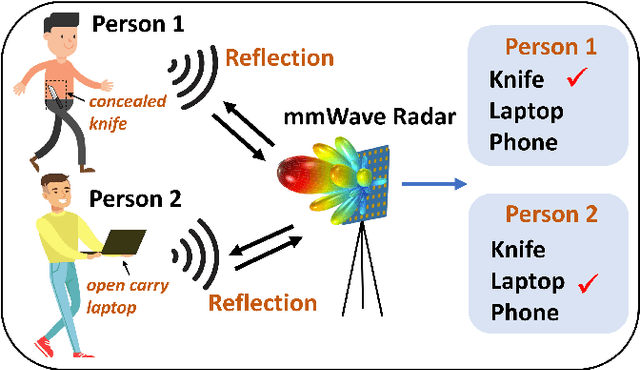
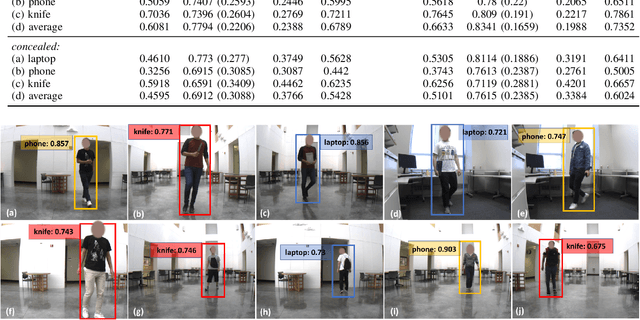
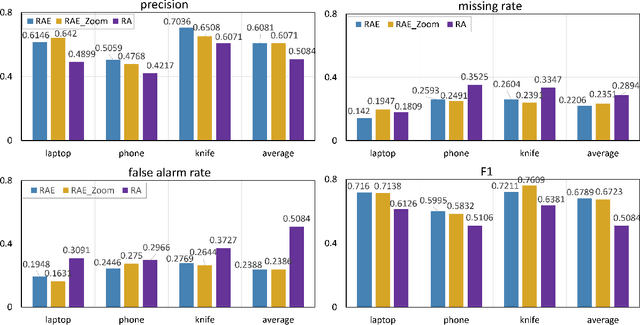

Abstract:Detecting harmful carried objects plays a key role in intelligent surveillance systems and has widespread applications, for example, in airport security. In this paper, we focus on the relatively unexplored area of using low-cost 77GHz mmWave radar for the carried objects detection problem. The proposed system is capable of real-time detecting three classes of objects - laptop, phone, and knife - under open carry and concealed cases where objects are hidden with clothes or bags. This capability is achieved by initial signal processing for localization and generating range-azimuth-elevation image cubes, followed by a deep learning-based prediction network and a multi-shot post-processing module for detecting objects. Extensive experiments for validating the system performance on detecting open carry and concealed objects have been presented with a self-built radar-camera testbed and dataset. Additionally, the influence of different input, factors, and parameters on system performance is analyzed, providing an intuitive understanding of the system. This system would be the very first baseline for other future works aiming to detect carried objects using 77GHz radar.
Perception Through 2D-MIMO FMCW Automotive Radar Under Adverse Weather
Apr 23, 2021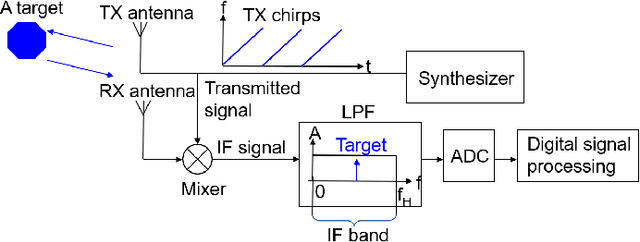

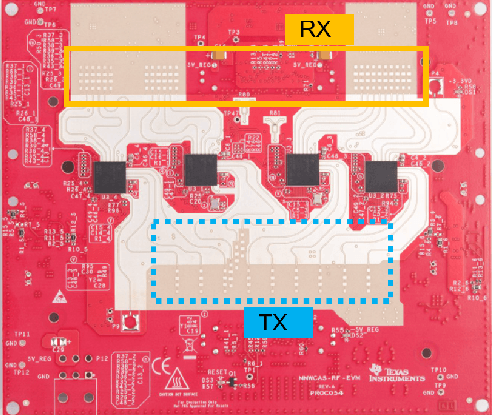
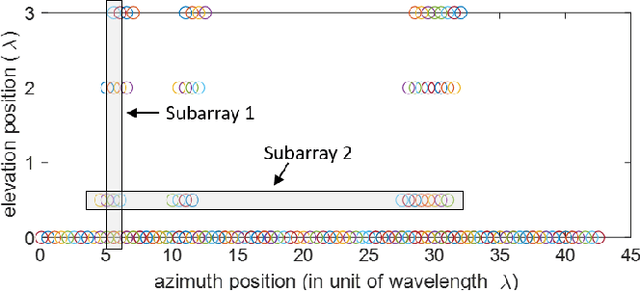
Abstract:Millimeter-wave (mmWave) radars are being increasingly integrated in commercial vehicles to support new Adaptive Driver Assisted Systems (ADAS) features that require accurate location and Doppler velocity estimates of objects, independent of environmental conditions. To explore radar-based ADAS applications, we have updated our test-bed with Texas Instrument's 4-chip cascaded FMCW radar (TIDEP-01012) that forms a non-uniform 2D MIMO virtual array. In this paper, we develop the necessary received signal models for applying different direction of arrival (DoA) estimation algorithms and experimentally validating their performance on formed virtual array under controlled scenarios. To test the robustness of mmWave radars under adverse weather conditions, we collected raw radar dataset (I-Q samples post demodulated) for various objects by a driven vehicle-mounted platform, specifically for snowy and foggy situations where cameras are largely ineffective. Initial results from radar imaging algorithms to this dataset are presented.
MIMO-SAR: A Hierarchical High-resolution Imaging Algorithm for FMCW Automotive Radar
Jan 22, 2021
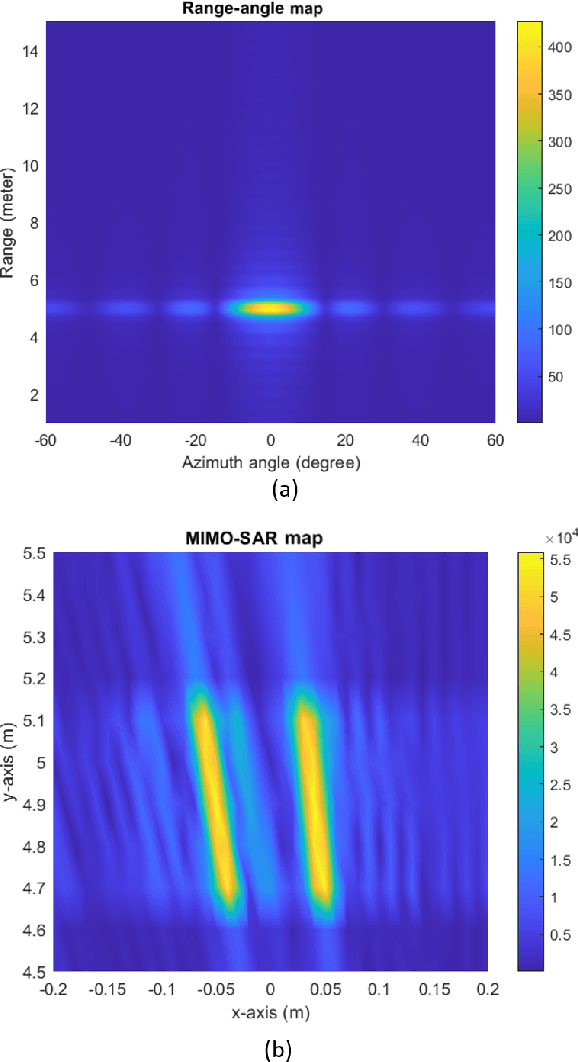
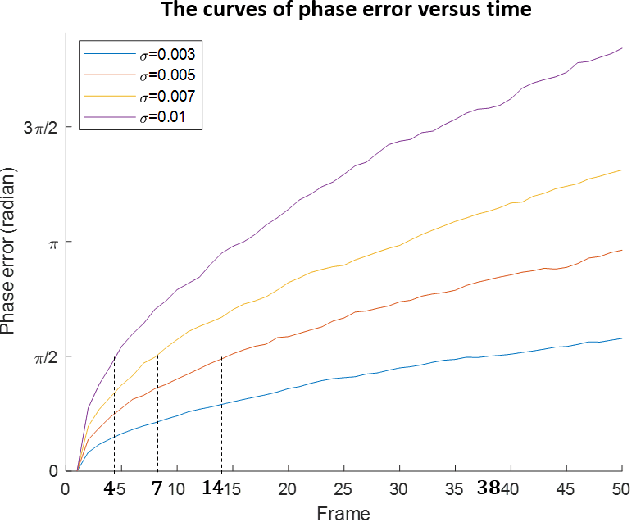
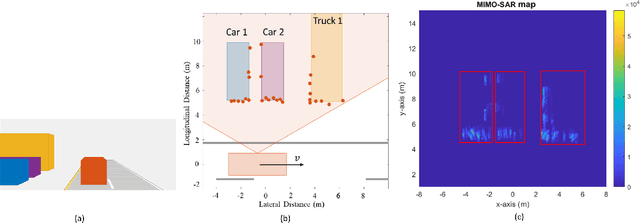
Abstract:Millimeter-wave radars are being increasingly integrated into commercial vehicles to support advanced driver-assistance system features. A key shortcoming for present-day vehicular radar imaging is poor azimuth resolution (for side-looking operation) due to the form factor limits on antenna size and placement. In this paper, we propose a solution via a new multiple-input and multiple-output synthetic aperture radar (MIMO-SAR) imaging technique, that applies coherent SAR principles to vehicular MIMO radar to improve the side-view (angular) resolution. The proposed 2-stage hierarchical MIMO-SAR processing workflow drastically reduces the computation load while preserving image resolution. To enable coherent processing over the synthetic aperture, we integrate a radar odometry algorithm that estimates the trajectory of ego-radar. The MIMO-SAR algorithm is validated by both simulations and real experiment data collected by a vehicle-mounted radar platform (see Fig. 1).
RAMP-CNN: A Novel Neural Network for Enhanced Automotive Radar Object Recognition
Nov 13, 2020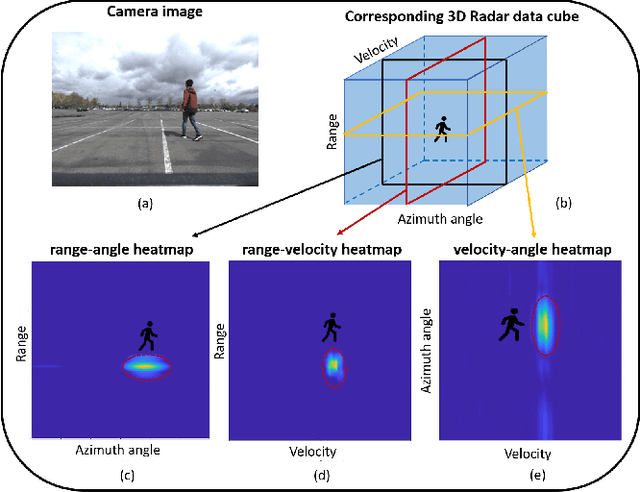
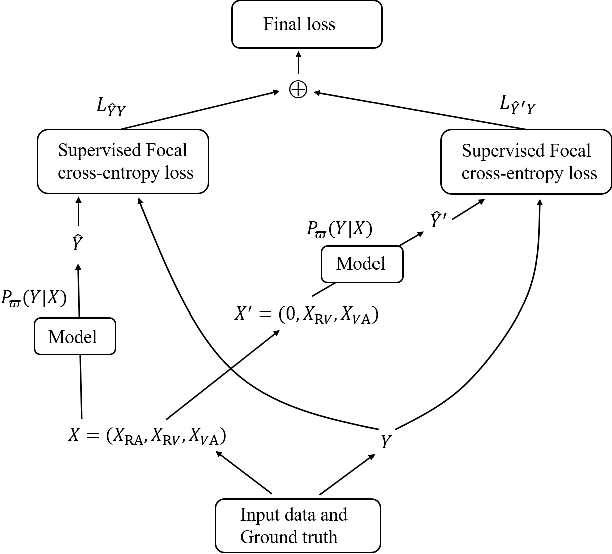
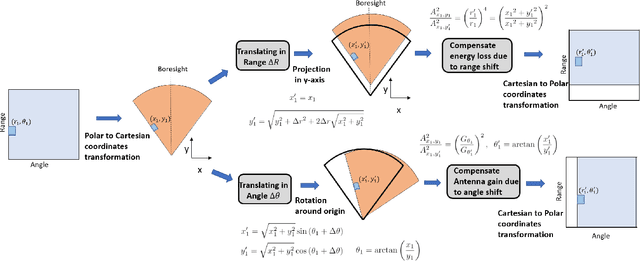
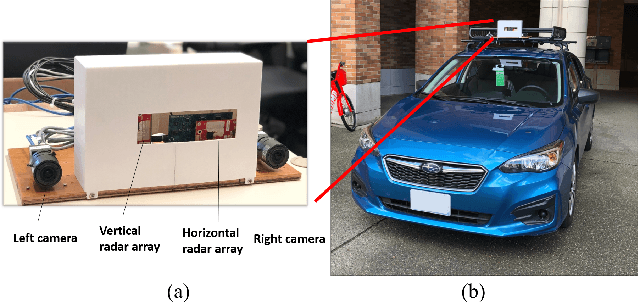
Abstract:Millimeter-wave (mmW) radars are being increasingly integrated into commercial vehicles to support new advanced driver-assistance systems (ADAS) by enabling robust and high-performance object detection, localization, as well as recognition - a key component of new environmental perception. In this paper, we propose a novel radar multiple-perspectives convolutional neural network (RAMP-CNN) that extracts the location and class of objects based on further processing of the range-velocity-angle (RVA) heatmap sequences. To bypass the complexity of 4D convolutional neural networks (NN), we propose to combine several lower-dimension NN models within our RAMP-CNN model that nonetheless approaches the performance upper-bound with lower complexity. The extensive experiments show that the proposed RAMP-CNN model achieves better average recall (AR) and average precision (AP) than prior works in all testing scenarios (see Table. III). Besides, the RAMP-CNN model is validated to work robustly under the nighttime, which enables low-cost radars as a potential substitute for pure optical sensing under severe conditions.
* 15 pages
 Add to Chrome
Add to Chrome Add to Firefox
Add to Firefox Add to Edge
Add to Edge